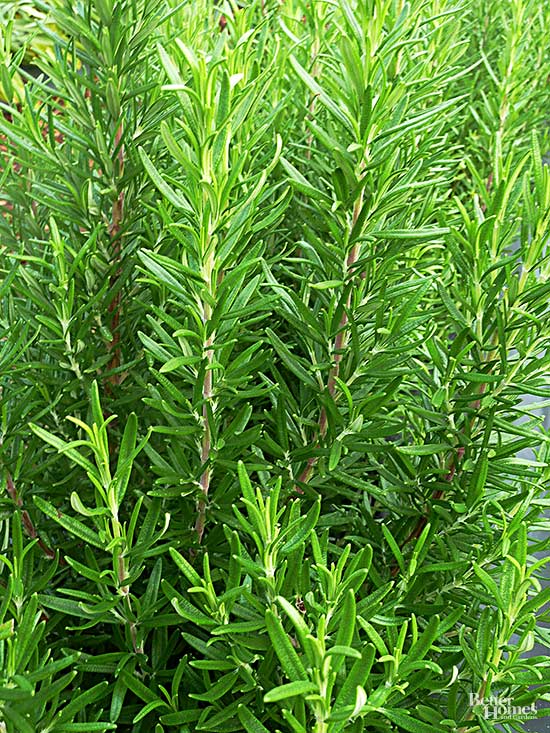






The name rosemary, a shrubby evergreen perennial herb that's native to Mediterranean climates, comes from Latin words that mean "dew of the sea." If you bear in mind that rosemary's native habitat is dry, sunny, and warm but not blazing hot, you'll have a good idea of how to grow it.
Rosemary plants need well-drained soil and at least eight hours of sun daily. If you live in a warm climate, usually USDA Zone 7-8 or warmer, tall rosemary varieties can grow into veritable bushes that can reach 6 feet tall and 4 or 5 feet wide over time. There are also prostrate forms of rosemary that grow like groundcovers.
Proper watering is essential for keeping rosemary happy. Water rosemary thoroughly but allow the soil to dry out between waterings. Soil that retains water easily can make this difficult, so be sure the soil drains rapidly. However, if the slender needlelike leaves dry out, you waited too long to water the rosemary plant.
Although most herbs do not need much additional fertilizer, you can fertilize it every few weeks with a weak liquid fertilizer to promote leaf growth. Use a balanced fertilizer (such as 10-10-10) to promote complete plant health.
Choose from a wide variety of rosemary varieties, including those with different growing habits, such as erect, trailing, creeping, and those with slightly different tastes, flower colors, and scents.
continue reading belowGardeners and cooks in northern climates may want to grow rosemary in a pot so they can bring it inside when frost threatens. Rosemary doesn't like its roots disturbed, so if you grow it in the ground, then dig it up to pot it for winter, your chances of success are lowered.
When you bring a rosemary plant indoors for winter, place it in a cool but sunny location with high humidity. This can be a difficult location to find! One way to raise humidity without increasing soil moisture is to place some small pebbles or beads on a saucer, add water, and set the potted rosemary plant atop the pebbles.
When watering rosemary, bring the pot to a sink, allowing all excess water to drain out of the pot. If you use a saucer, be sure to remove any water so the rosemary plant does not stand in water.
A good potting mix for rosemary allows good drainage. You can buy a potting mix that's rated for cactus, or you can make your own mix from two parts potting mix, two parts peat, one part sand, and one part compost.
Rosemary is a little challenging to start from seed. Because it can take up to three weeks for seeds to germinate, it's best to start inside in early spring. In a soilless seed starting mix, space seeds 1 inch apart and just barely covered with mix. Keep the potting medium moist but not soggy. Cover the seeds with plastic wrap, keep the temperature between 60 and 70 degrees F, and place the seeds under a grow-light or in strong sunlight.
As soon as the seeds germinate, remove the plastic and continue growing the plants until each has several sets of leaves. Transplant each young rosemary seedling into its own 4- to 6-inch pot, then into the ground or a pot once all danger of frost has passed. It may take several years for seedlings to grow large.
To grow rosemary from a cutting, snip about 3 inches of a stem from an existing rosemary plant. Trim the leaves off the lower 1½ inches and tuck that much of the cut end into soil in a 3-inch pot. Keep the soil around the cutting moist but not soggy and keep it in a sunny location that says about 60 to 70 degrees F. The cutting should be rooted in about eight weeks.
Training rosemary into a specific shape, such as a lollipop-style tree, can take several years. To train a rosemary topiary -- a traditional cone shape is popular for Christmas -- and routinely trim the plant to the shape you want. Pruning encourages new growth at the tips where you cut, so the more you cut, the bushier it gets.
Rosemary can be used either fresh or dried. The stems make terrific skewers for small grilled kebabs of meat or vegetables. Rosemary complements most meats, including pork, beef, lamb, and chicken. It's a natural in tomato sauces for pasta and pizza. It's delicious used in rustic breads such as foccacia or on roasted potatoes.
Rosemary has a strong flavor, so use a light touch until you know how much you like in a particular recipe.
Step-by-step instructions to a festive rosemary topiary
Garlicky rosemary stuffing recipe
Copyright © www.100flowers.win Botanic Garden All Rights Reserved